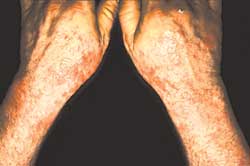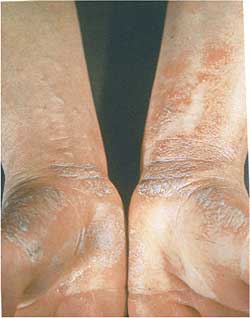These Problems Aren't Set in Stone
Concrete burns are a serious, sometimes disabling problem for exposed workers. Medical tests cannot predict who will get skin problems.
- By Chris Trahan, CIH, Mary Watters
- Mar 01, 2007
 CONCRETE
CONCRETE pours thick and cool, like a mud milkshake. On a hot day it may even seem inviting, as more than one homeowner has stepped in, shoeless, to level the surface of a driveway. So the idea that this seemingly harmless substance could be responsible for severe burns runs counter to common sense.
You don't have to convince one cement mason named Ryan. He was working a slip-form concrete pour for a grain storage silo, a 24-hour operation that would take 16 days and involve cement masons, ironworkers, laborers, and concrete truck drivers. He was halfway through his 12-hour shift when it started to rain. The concrete pour continued, of course, and the rain continued through the next six hours. He finished his shift soaked to the skin.
Unfortunately, the concrete also soaked through his clothing, working its way through to his hands, arms, knees, and ankles. Hours after leaving the job, his skin started to peel off his arms and legs. "It felt like a bad sunburn," Ryan said. Other workers experienced similar problems. One ironworker went to a hospital emergency room, and health professionals applied an ointment that made the burn even worse.
That's the "sneak attack" of concrete burns. Concrete is highly caustic and works slowly, so a burn can develop over hours or even days. Left unattended, a concrete burn could blister, swell, ooze, and bleed. In fact, second- or third-degree burns may occur after short exposures. Once the burn is noticed, much damage has already occurred and further damage is difficult to stop. In severe cases, burns can go down to the bone, leaving disfiguring scars or disability. Skin grafts are not uncommon. Skin and tissue damage can be so severe as to require limb amputation.
How could something as non-threatening as concrete or cement result in amputation? It comes down to three factors: the abrasive nature of concrete and cement, its high pH levels, and its stew of sensitizing chemicals and metals. Portland cement, which is in concrete and many other products, contributes to concrete burns and other skin problems. It often contains the metal hexavalent chromium, a toxic form of the element chromium that causes severe skin problems in some workers.
Who Gets Exposed
Because concrete and portland cement are abrasive, they cause micro cuts and scrapes to the skin. Portland cement is a highly alkaline (caustic) material, and it actually can absorb moisture from the skin, leaving it dry and red. To realize just how foreign portland cement is to the body, consider that water is pH 7 (neutral), but human skin is acidic and has a pH of about 4.5. Vinegar, a weak acid, has a pH of 3.5, while battery acid (sulfuric acid) has a pH of 1. Strong alkalies have pH values between 12 and 14. Wet cement is near the top of the charts with a pH that ranges from 12 to 13.
For people working in or around concrete or other products with portland cement, such as fresh mortar and grout, the damage is not always a burn. Skin problems range from mild itching and scaling to a disabling immune-response skin condition that forces many workers to change jobs. These skin problems can be short-lived or persistent. They can occur after a single exposure--or after multiple exposures. Medical tests cannot predict who will get skin problems.
The list of construction tasks exposing workers to portland cement is vast. Some tasks, compiled in "A Safety & Health Practitioner's Guide to Skin Protection," are mixing and spreading grout, terrazzo work, hosing out concrete trucks, using mortar to set brick and block, mixing mortar, dismantling formwork contaminated by portland cement, leveling and finishing concrete, mixing and applying plaster and stucco, spraying portland cement products such as fireproofing or shotcrete, and grinding finished concrete or tuckpointing brick mortar. Clearly, hundreds of thousands of construction workers are exposed to hazards of portland cement products.
Burns, Allergies, and Irritants
Concrete burns require immediate medical attention. While in transit, many medical professionals advise flushing the skin with lots of clean water. Some medical experts recommend adding vinegar or citrus to the water to neutralize the caustic effect.
Upon locating a medical professional, he or she should be told that the problem is a caustic burn from cement because the burn can look like a standard trauma burn. The skin blisters or is dead or hardened. It may even turn black and green. Treating a concrete burn with ointments that would soothe a normal burn may trap the corrosive materials against the skin, which makes the burn worse, as happened with the ironworker on the silo slip-form pour who went to the ER.
Unfortunately, concrete burns are far too common. A 1997 survey found 35 percent of apprentice concrete masons nationwide had received a concrete burn. Concrete burns can make workers more susceptible to allergic contact dermatitis (ACD). The skin develops an allergy to the sensitizing materials in portland cement, especially hexavalent chromium. Other materials in concrete, such as epoxies, can cause ACD. An allergic reaction can be a combination of stinging, itching, dead skin, blisters, scabs, scaling, fissures, redness, a rash, swelling, bumps, and watery discharge. ACD is difficult to cure, and the allergy may be lifelong. With each exposure, symptoms can reappear, which forces many workers out of the trades. But it doesn't take a concrete burn to contract ACD; the skin problem can develop on exposed workers without any warning.
Workers also can develop irritant contact dermatitis (ICD) from the abrasive nature of cement and its high pH. ICD has the same symptoms of ACD: stinging, dead skin, etc. The good news: It's easier to treat than ACD. The bad news: Repeated incidents of ICD can lead to ACD.
Protecting Workers
These skin problems also have a cost in worker productivity. Concrete workers have four times more lost work days for skins problems than do all construction workers, according to reports. Lost work days for skin problems among the masonry trades are two-and-a-half times the national average.
But lost days, pain, and even hospitalization can be avoided by following safety guidelines. Workers, work-site supervisors, and employers all play a role in job site safety and worker health.
- Wash your hands before applying gloves. If your hands have concrete dust or irritating compounds on them, putting on gloves traps these contaminants against your skin. One study found that wearing gloves without first cleaning the hands is as damaging as working without gloves.
- Use a pH-neutral soap and clean nail beds. Ask your pharmacists to suggest a pH-neutral soap or cleanser to use both at home and work. Most liquid hand soaps are pH neutral.
- Wash (and dry) your hands several times a day. Use a pH-neutral soap and water; wash before eating, taking a break, when you stop work, and whenever you remove your gloves. If clean, running water is not available, use a commercially available hand rinse designed for cement and concrete work or carry a vinegar-soaked washcloth in a plastic bag. The vinegar's acid cuts the alkaline portland cement.
- Avoid petroleum jelly, creams, and lotions with lanolin. Petroleum jelly or creams can "seal" hands, but the abrasiveness of cement can break the seal. Applying these products at work could trap contaminants against the skin, worsening problems. Many creams and lotions have lanolin, which triggers allergic reactions in some people.
- Remove watches and jewelry. Rings, chains, and watches can trap cement and quickly irritate the skin.
- Keep work clothes separate--boots, too! If you can't leave your work clothes at work, take them home in a separate container, such as a trash bag. Wash work clothes separate from family laundry.
- Clean car or truck interiors if you drive home in work clothes. One worker's daughter developed a painful skin rash and all treatment failed. The worker discovered portland cement was present in his truck cab and boots. Once he cleaned his truck cab and started changing out of work clothes before getting into his truck, his daughter's skin problem disappeared--and so did his.
- Read the label and the MSDS sheets. If possible, get the cement or concrete product bag and check for a safety warning and list of ingredients. Read the Material Safety Data Sheet for the product. MSDSs are required by law; they list the ingredients and possible health hazards. Everyone working on the site has a right to see MSDSs.
- Choose portland cement without hexavalent chromium. The concentration of hexavalent chromium in portland cement varies widely. Contractors and owners should purchase portland cement with a hexavalent chromium content of less than 2 ppm, which greatly reduces the risk of ACD.
- See a doctor. A persistent skin problem, even a minor one, should be noted by a physician. Tell your doctor about the products you use at work.
The largest organ of the human body is the skin, covering a surface of approximately 20 square feet. Reducing exposure to portland cement products and concrete will help keep workers and their families healthy.
For more information on concrete burns, visit the Electronic Library of Construction Occupational Safety and Health at www.elcosh.org.
This article appeared in the March 2007 issue of Occupational Health & Safety.
This article originally appeared in the March 2007 issue of Occupational Health & Safety.